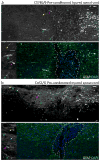Robust Axonal Regeneration Occurs in the Injured CAST/Ei Mouse CNS
- PMID: 26004914
- PMCID: PMC4458182
- DOI: 10.1016/j.neuron.2015.05.005
Robust Axonal Regeneration Occurs in the Injured CAST/Ei Mouse CNS
Abstract
Axon regeneration in the CNS requires reactivating injured neurons' intrinsic growth state and enabling growth in an inhibitory environment. Using an inbred mouse neuronal phenotypic screen, we find that CAST/Ei mouse adult dorsal root ganglion neurons extend axons more on CNS myelin than the other eight strains tested, especially when pre-injured. Injury-primed CAST/Ei neurons also regenerate markedly in the spinal cord and optic nerve more than those from C57BL/6 mice and show greater sprouting following ischemic stroke. Heritability estimates indicate that extended growth in CAST/Ei neurons on myelin is genetically determined, and two whole-genome expression screens yield the Activin transcript Inhba as most correlated with this ability. Inhibition of Activin signaling in CAST/Ei mice diminishes their CNS regenerative capacity, whereas its activation in C57BL/6 animals boosts regeneration. This screen demonstrates that mammalian CNS regeneration can occur and reveals a molecular pathway that contributes to this ability.
Copyright © 2015 Elsevier Inc. All rights reserved.
Figures







Similar articles
-
Complement protein C1q modulates neurite outgrowth in vitro and spinal cord axon regeneration in vivo.J Neurosci. 2015 Mar 11;35(10):4332-49. doi: 10.1523/JNEUROSCI.4473-12.2015. J Neurosci. 2015. PMID: 25762679 Free PMC article.
-
Overexpression of Sox11 promotes corticospinal tract regeneration after spinal injury while interfering with functional recovery.J Neurosci. 2015 Feb 18;35(7):3139-45. doi: 10.1523/JNEUROSCI.2832-14.2015. J Neurosci. 2015. PMID: 25698749 Free PMC article.
-
NT-3 promotes proprioceptive axon regeneration when combined with activation of the mTor intrinsic growth pathway but not with reduction of myelin extrinsic inhibitors.Exp Neurol. 2016 Sep;283(Pt A):73-84. doi: 10.1016/j.expneurol.2016.05.021. Epub 2016 Jun 2. Exp Neurol. 2016. PMID: 27264357 Free PMC article.
-
Enhancing intrinsic growth capacity promotes adult CNS regeneration.J Neurol Sci. 2012 Jan 15;312(1-2):1-6. doi: 10.1016/j.jns.2011.08.037. Epub 2011 Sep 16. J Neurol Sci. 2012. PMID: 21924742 Review.
-
[Strategies to repair lost sensory connections to the spinal cord].Mol Biol (Mosk). 2008 Sep-Oct;42(5):820-9. Mol Biol (Mosk). 2008. PMID: 18988531 Review. Russian.
Cited by
-
PDE2A Inhibition Enhances Axonal Sprouting, Functional Connectivity, and Recovery after Stroke.J Neurosci. 2022 Nov 2;42(44):8225-8236. doi: 10.1523/JNEUROSCI.0730-22.2022. Epub 2022 Sep 26. J Neurosci. 2022. PMID: 36163142 Free PMC article.
-
Tackling the glial scar in spinal cord regeneration: new discoveries and future directions.Front Cell Neurosci. 2023 May 24;17:1180825. doi: 10.3389/fncel.2023.1180825. eCollection 2023. Front Cell Neurosci. 2023. PMID: 37293626 Free PMC article. Review.
-
Reconnecting Eye to Brain.J Neurosci. 2016 Oct 19;36(42):10707-10722. doi: 10.1523/JNEUROSCI.1711-16.2016. J Neurosci. 2016. PMID: 27798125 Free PMC article. Review.
-
The Dorsal Column Lesion Model of Spinal Cord Injury and Its Use in Deciphering the Neuron-Intrinsic Injury Response.Dev Neurobiol. 2018 Oct;78(10):926-951. doi: 10.1002/dneu.22601. Epub 2018 May 11. Dev Neurobiol. 2018. PMID: 29717546 Free PMC article. Review.
-
The challenge of regenerative therapies for the optic nerve in glaucoma.Exp Eye Res. 2017 Apr;157:28-33. doi: 10.1016/j.exer.2017.01.007. Epub 2017 Jan 30. Exp Eye Res. 2017. PMID: 28153739 Free PMC article. Review.
References
-
- Benowitz LI, Popovich PG. Inflammation and axon regeneration. Curr Opin Neurol. 2011;24:577–583. - PubMed
-
- Benowitz LI, Yin Y. Combinatorial treatments for promoting axon regeneration in the CNS: strategies for overcoming inhibitory signals and activating neurons’ intrinsic growth state. Dev Neurobiol. 2007;67:1148–1165. - PubMed
-
- Chang HL, Jovanis PP. Formulating accident occurrence as a survival process. Accident; analysis and prevention. 1990;22:407–419. - PubMed
Publication types
MeSH terms
Grants and funding
LinkOut - more resources
Full Text Sources
Other Literature Sources
Medical
Molecular Biology Databases
Miscellaneous

